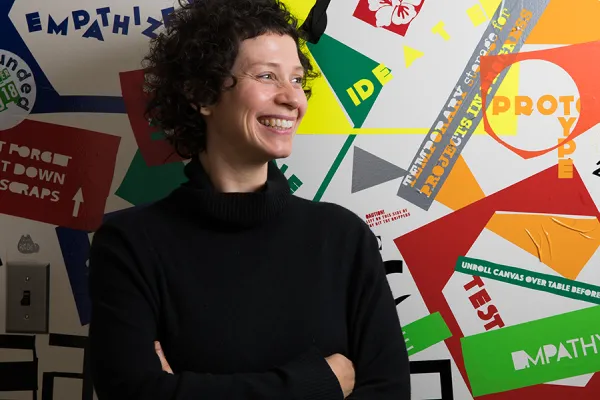The Power of Design
Research & Inquiry

Published November 30, 2018
Emily Norton, the new co-director of Smith’s Design Thinking Initiative, grew up in Warren, Vt., in a “design build” community founded by architects interested in environmentally sound development.
Later, her interest in design led her to the Rhode Island School of Design, where she earned a bachelor of fine arts degree in furniture design, and then to the Design Academy Eindhoven in the Netherlands, where she earned a master of design degree in contextual design. She also worked for six years at a design thinking firm in Providence, R.I.
Norton—who began work at Smith in October—says she is excited about being part of Smith’s Design Thinking Initiative as it moves from a multi-year pilot phase into a long-term partnership with the college’s Conway Innovation & Entrepreneurship Center and Wurtele Center for Leadership.
“The mission to empower young people to do design is something I’m super jazzed about,” says Norton, who will teach design thinking courses during Interterm and spring semester. “I’m a real believer in the power of design to give people agency in shaping the world.”
Here’s what else Norton had to say about her work at Smith.
What is your role in this new stage of the Design Thinking Initiative?
“It’s wonderful that a strong foundation for the initiative got started in the pilot phase. I see my role as building on that foundation, taking a look at what’s been working best with regard to our curriculum enhancement grants, student engagement and the role of making on campus. We will be offering more workshops and trainings, and continuing the Summer Design Immersions program. Next fall, I am excited to reopen the Speaking of Design series with not just lectures, but also workshop opportunities. We’re looking for ways we might deepen our impact and continue to be a resource for the campus community—and beyond.”
What aspects of your experience in the design field prepared you for your role at Smith?
“I come from an art and design background. My big takeaway from art school was that working with materials—bending steel or wood, for instance—gives us a sense that we have the power to manipulate the world around us, and that it needs to be done responsibly. That dovetails with design thinking—a mindset that involves stretching boundaries, questioning assumptions and then applying ideas in political, business or educational contexts.
I learned in the Netherlands that I was most excited by real world challenges, and most engaged when working as a team. Later, when I was at the design studio in Rhode Island, I had the opportunity to work with a number of school communities that wanted to integrate design thinking into their schools.
When I heard about Smith’s Design Thinking Initiative, it was all of those things together—an emphasis on making, a chance to explore design in the context of the liberal arts, and the opportunity to teach.”
What’s unique about Smith’s approach to design thinking?
“The social justice component is absolutely something that sets us apart. What really spoke to me about Smith’s initiative was the question of who gets to design, and designing in the service of broader social issues. Historically, it’s been an elite few who get to call themselves designers. The mission here is to extend that capacity.”
What has struck you most about Smith?
“I am totally floored by the wherewithal and the thoughtfulness of Smith students. I’m really excited to be here, and I hope people will keep an eye out for how we are evolving as we transition from the pilot phase of the Design Thinking Initiative and continue to find ways to support the whole campus community in capacity-building.”